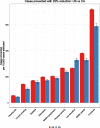Importance of Accounting for Regional Differences in Modifiable Risk Factors for Alzheimer's Disease and Related Dementias: The Case for Tailored Interventions
- PMID: 35938249
- PMCID: PMC9535596
- DOI: 10.3233/JAD-220278
Importance of Accounting for Regional Differences in Modifiable Risk Factors for Alzheimer's Disease and Related Dementias: The Case for Tailored Interventions
Abstract
Background: We recently estimated that 36.9% of Alzheimer's disease and related dementias (ADRD) cases in the US may be attributable to modifiable risk factors, but it is not known whether national estimates generalize to specific states or regions.
Objective: To compare national estimates of modifiable risk factors of ADRD to California, overall and by sex and race/ethnicity, and to estimate number of cases potentially preventable by reducing the prevalence of key risk factors by 25%.
Methods: Adults ≥18 years who participated in the Behavioral Risk Factor Surveillance Survey in California (n = 9,836) and the US (n = 378,615). We calculated population attributable risks (PARs) for eight risk factors (physical inactivity, current smoking, depression, low education, diabetes mellitus, midlife obesity, midlife hypertension, and hearing loss) and compared estimates in California and the U.S.
Results: In California, overall, 28.9% of ADRD cases were potentially attributable to the combination of risk factors, compared to 36.9% in the U.S. The top three risk factors were the same in California and the U.S., although their relative importance differed (low education [CA:14.9%; U.S.:11.7% ], midlife obesity [CA:14.9%; U.S.:17.7% ], and physical inactivity [CA:10.3%; U.S.:11.8% ]). The number of ADRD cases attributable to the combined risk factors was 199,246 in California and 2,287,683 in the U.S. If the combined risk factors were reduced by 25%, we could potentially prevent more than 40,000 cases in California and 445,000 cases in the U.S.
Conclusion: Our findings highlight the importance of examining risk factors of ADRD regionally, and within sex and race/ethnic groups to tailor dementia risk reduction strategies.
Keywords: Alzheimer’s disease; dementia; prevention; public health; risk factors.
Conflict of interest statement
Authors’ disclosures available online (
Figures
Similar articles
-
Risk Factors Associated With Alzheimer Disease and Related Dementias by Sex and Race and Ethnicity in the US.JAMA Neurol. 2022 Jun 1;79(6):584-591. doi: 10.1001/jamaneurol.2022.0976. JAMA Neurol. 2022. PMID: 35532912 Free PMC article.
-
Potential for primary prevention of Alzheimer's disease: an analysis of population-based data.Lancet Neurol. 2014 Aug;13(8):788-94. doi: 10.1016/S1474-4422(14)70136-X. Lancet Neurol. 2014. PMID: 25030513
-
Modifiable Risk Factors for Alzheimer's Disease and Related Dementias Among Middle Eastern and North African Immigrants to the United States.Innov Aging. 2024 Feb 29;8(3):igae025. doi: 10.1093/geroni/igae025. eCollection 2024. Innov Aging. 2024. PMID: 38524244 Free PMC article.
-
The projected effect of risk factor reduction on Alzheimer's disease prevalence.Lancet Neurol. 2011 Sep;10(9):819-28. doi: 10.1016/S1474-4422(11)70072-2. Epub 2011 Jul 19. Lancet Neurol. 2011. PMID: 21775213 Free PMC article. Review.
-
Alzheimer's Disease and Related Dementia in Indigenous Populations: A Systematic Review of Risk Factors.J Alzheimers Dis. 2020;78(4):1439-1451. doi: 10.3233/JAD-200704. J Alzheimers Dis. 2020. PMID: 33185601
References
-
- Alzheimer’s Association (2019) 2019 Alzheimer’s disease facts and figures. Alzheimers Dementia 15, 321–387.
-
- United States Census Bureau. California 2020 Census.
-
- CDC-BRFSS. Centers for Disease Control (CDC) - BRFSS. https://www.cdc.gov/brfss/index.html.
-
- Alzheimer’s Association. California’s State Plan for Alzheimer’s Disease: An Action Plan for 2011-2021. https://www.alz.org/national/documents/stateplan-calif.pdf. Accessed September 20, 2021.
Publication types
MeSH terms
LinkOut - more resources
Full Text Sources
Medical
Miscellaneous


